A Scion Society of The Baker Street Irregulars
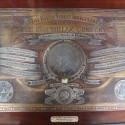
The Mystery of the Three Irregular Plates (2014)
“… it is a mystery to me …”
– The Adventure of The Norwood Builder (NORW)
For the connoisseur of BSI History, of chief interest by far during the BSI weekend in New York this January 2013 were the two brass plates displayed at Saturday morning’s hucksters room by Madrid antiques dealer Javier Doria. Something like 9½ by 13½ inches in size, mounted on wood plaques one of which bore the handles of a tray, they looked to my first glance like plates designed to print enormous currency bills, because both included the Great Seal of the United States and the mystical Annuit Cœptis seal also found on the reverse of the U.S. one-dollar bill.
Instead they honored the Baker Street Irregulars, 1940’s annual dinner at the Murray Hill Hotel, and Vincent Starrett’s anthology of BSI writings 221B: Studies in Sherlock Holmes, for which that January 30th, 1940 dinner— first in four years — was a publication party, with everyone present receiving a copy of the book hot off the press. (See my BSJ Christmas Annual about that dinner.) Both plates feature a profile of Sherlock Holmes by Frederic Dorr Steele, as well as conspicuous mentions of the Baker Street Irregulars, the book’s title, the MacMillan Company that published it, the BSI dinner and the Murray Hill Hotel where it was held.
All who beheld them were flabbergasted, including me.
But there are interesting differences between the plates as well. One has, on either side of Steele’s art (surrounded on both plates by the words “Sir Arthur Conan Doyle • Literary Agent”), two fingerprints engraved inside circular labels. Both say, in the lower half, “Partner in Crime”; in their upper halves, the one to the left of Steele’s art has Vincent Starrett’s name, the one to the other Harold S. Latham’s. Latham was the trade editor at MacMillan, and perhaps responsible for publishing also Starrett’s Private Life of Sherlock Holmes in 1933 as well. Latham was a doughty figure in American publishing from the 1920s on, but I regret to report that his 1965 memoir My Life in Publishing, brought out by Dutton, not MacMillan, fills 256 pages of reminiscences without once mentioning Vincent Starrett, Sherlock Holmes, the BSI, or these extraordinary plates.)
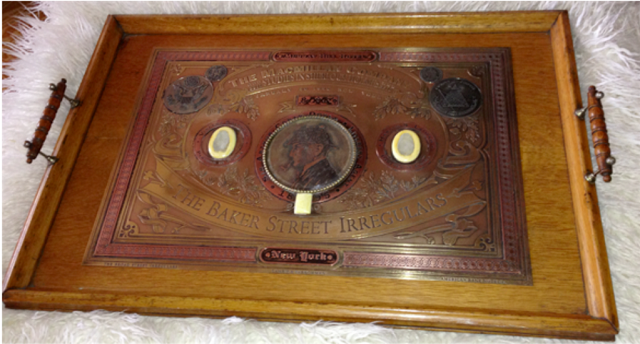

However, gazing at them that morning in January 2013, I noticed along their bottom edges three statements. The left corners reads THE BROAD STREET IRREGULARS. In center,LAMBIE & BARROWMAN. The right corner, AMERICAN BANK NOTE CO.
When I saw the last one, I realized who must be a key to this mystery (not that it alone would prove to unlock the door). For one early Baker Street Irregular, present at the 1940 dinner, was an American Bank Note Company executive named Allan Price. Its offices were at 70 Broad Street in New York’s financial district, illuminating the “Broad Street Irregulars” statement.
But LAMBIE & BARROWMAN baffled me. Helen Lambie and Mary Barrowman were key witnesses in the Oscar Slater murder case of 1927, in which Conan Doyle interested himself, but why their names should be on these plates, I have no idea. It may have been a private joke we will never understand, or mean something else. But since guessing is damaging to the logical faculties, I decline to do so.
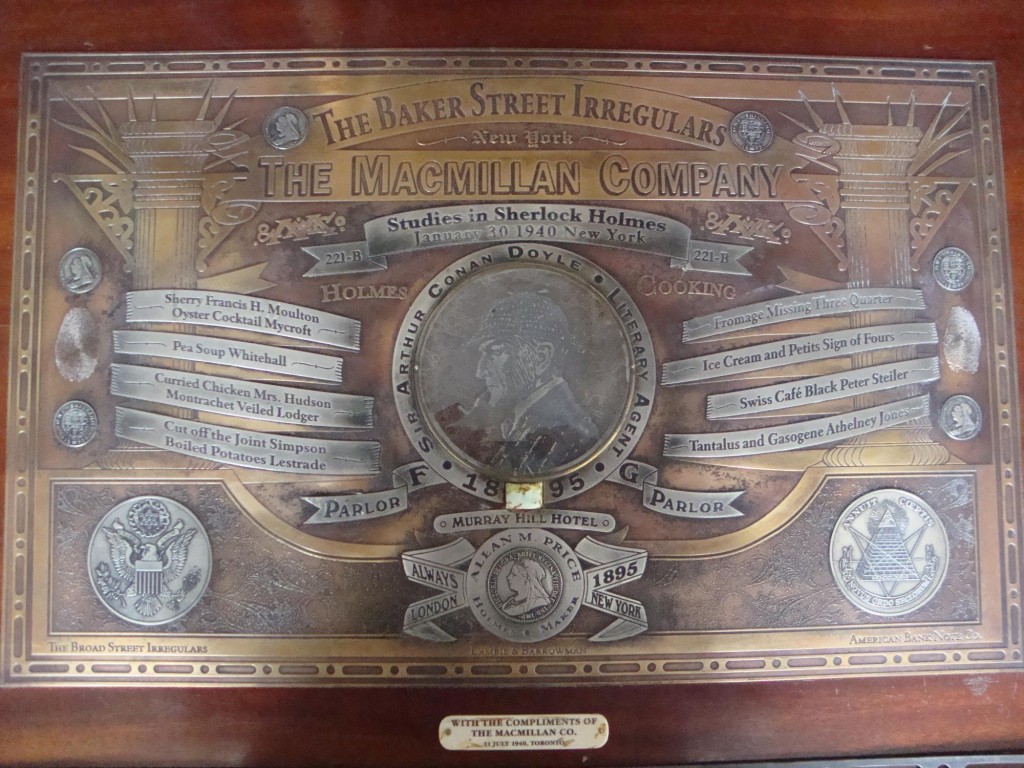
Price’s name actually appeared on the second of the two plates, I found, in a smaller medallion below Steele’s art, encompassing a Victorian shilling (Which would not be a token of BSI membership for another ten years.), its circular label reads “Allan M. Price” in the upper half, and the words “Holmes Maker” in the lower half. Where Starrett’s and Latham’s fingerprints were on the first plate, were this time eight banners wrapping around columns near the left and right edges, bearing the fancifully named dishes served at the 1940 BSI dinner, per that night’s menu reproduced on p. 225 of my book Irregular Memories of the ’Thirties, and in my BSJ Christmas Annual. [1998, “Entertainment and Fantasy”: The 1940 Dinner.
Nothing in the voluminous contemporary Irregular correspondence I’ve read has so much as hinted at the existence of these extraordinary plates. It is not clear exactly when they were made, let alone why. Surely not for (or at least not in time for) the BSI annual dinner itself, or there would be mention of them by Edgar W. Smith in his minutes of the dinner (pp. 222-24 in Irregular Memories of the ’Thirties, and in my BSJ Christmas Annual as well).
On the wooden plaque on which the second plate is mounted, there is a separate rectangular label, ivory in appearance and attached by two small screws, reading in its entirety:
WITH THE COMPLIMENTS OF
THE MACMILLAN CO.
11 JULY 1940 TORONTO
But the only event of that date in Toronto associated with MacMillan that I’ve so far been able to identify (in The Literary Legacy of the MacMillan Company of Canada by Ruth Panofsky, 2012) was the visit of MacMillan director George Platt Brett Jr. from New York after the sudden death of Hugh Eayrs, the Canadian branch’s principal.
So who was Allan Price, without whom these plates could not have been made by the American Bank Note Company?
He was born in Brooklyn, N.Y., on May 11, 1896. His father Henry, Brooklyn-born as well, was a concert singer and recitation artist whose wife often accompanied him on piano. Allan attended Brooklyn’s Polytechnic Preparatory School, and Hotchkiss School in Connecticut, before starting at Yale in the Class of 1919. He was in glee club, ROTC, and fencing at Yale, and a member of Alpha Delta Phi fraternity.
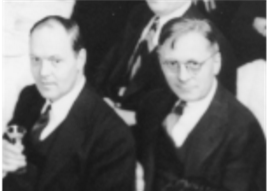
(Also class of ’19, and in that fraternity at the time, was Pierson Underwood, later a noted musicologist — another Irregular of the 1930s and ’40s, likely through Price’s introduction. They sat together at both the 1936 and 1940 BSI dinners; at the 1940 dinner below, Underwood is on the left and Price on the right.)
However, after America entered World War I in April 1917, Price broke off his studies to enlist in the Navy on May 17, 1917, remaining in it until April 17, 1919, by which time he was an Ensign.
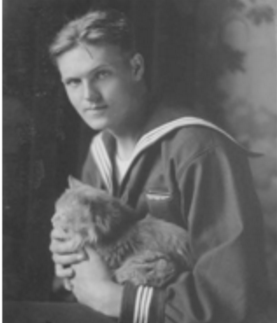
That spring, Yale conferred upon him a B.A. honoris causa. Returning to Brooklyn, he went to work as a claims investigator in the New York insurance offices of the T.G.R. Pierson Company. In 1920, he joined the American Bank Note Company, remaining there the rest of his life. He was a salesman for it until 1935, then its manager of domestic sales. On March 27, 1924, he and Harriette Lorraine Woodruff of New York (Smith College, class of ’21) were married, living and raising their children Cynthia and Woodruff at 1349 Lexington Avenue, Manhattan.
At some point, Price became part of Christopher Morley’s Three Hours for Lunch Club. While an American Bank Note Company officer seems unusual given in that club of mostly literary associations, we have it on the authority of Robert K. Leavitt and other undoubted fellow members.
The record is mute as to whether Price attended Morley’s January 6, 1934, birthday party for Sherlock Holmes at the Hotel Duane, the founding event for the Baker Street Irregulars. No list of attendees of any value exists to deny it, but no evidence has been seen by me suggesting that Price did. But in May he submitted a “near-perfect” solution to Frank Morley’s Sherlock Holmes Crossword in the Saturday Review of Literature, earning himself a place at the BSI’s “first formal meeting” at Christ Cella’s restaurant (formerly speakeasy) on June 5, 1934, and the first annual dinner also held there on December 7, 1934.
Price was back for the 1936 dinner at Cella’s, and after the BSI’s four-year hiatus, the January 30, 1940, dinner at the Murray Hill Hotel. He also attended 1941’s, but not 1942’s or 1943’s, and perhaps was suffering by then from the chronic heart disease of which he died at home, on February 16, 1943, only 46 years old. A brief obituary appeared in the New York Times the following day.
While Price left no written record as an Holmesian, he would not likely have been given table-space at either the Three Hours for Lunch Club nor Morley’s BSI had he not been an articulate gentleman of erudition and wit. In the March 1917 Yale Literary Magazine is the following poem by him, indicating a literary streak Morley would have appreciated, aside from knowledge of the Canon sufficient to be a Sherlock Holmes Crossword solver in 1934:
HARBOR SUNSET—NEW YORK
Seaward, a sapphire sky is strung with veils
Of smoke from harbor-craft. White jets of steam
Arise in cottony clouds, pink-flushed, a-gleam
With slanting rays, that strike the gliding sails,
New-white, or brown and patched from fighting gales —
Like sheets of flashing gold the white sails seem.
The sun has gone, but one forgotten beam
Kindles to flame the Goddess’ torch — then pales.
The city’s myriad windows spring alight,
One after one, until the huge pile glows.
While on the water moving lamps appear,
Their long reflections telling which the night
And which the harbor. And above all goes
The slim young moon o’er sky, star-filled and clear.
There were other mysteries about the plates. On the back of the wood plaques are newspaper clippings and other matter pasted to them, including the rubber-stamp mark MDIVANI PARIS 1948, suggesting that the plates came into the possession at some point of Denis Conan Doyle, who’d attended the 1940 BSI dinner, and who was married to the Georgian pretend-princess Nina Mdivani. It appears on a shipping label pasted to the back of one plate’s wooden plaque, for which a shipment, presumably the plates, was fancifully being sent to Stanley Hopkins OBE in care of Galerie Fischer, Lucerne, by Peter Steiler of the Englischer Hoff (sis), Meirengen 1891. This suggests a playful knowledge of the Canon one would not expect from the likes of Denis Conan Doyle and his wife or brother Adrian, let alone the even less initiated hands through which these plates have passed. In fact, the “Stanley Hopkins OBE” suggests Christopher Morley, who used that circumlocution occasionally for remarks of his own in his “Clinical Notes of a Resident Patient” column in the Original Series BSJ in the latter 1940s. These are deep waters.
Señor Doria had prepared for New York a sheet showing the putative migration of these mysterious plates long before he came across them in Lucerne in the course of business. It suggests that they passed, date unknown, from Robert Huckvale, president of Macmillan of Canada Ltd. in the 1940s, to Tony Harwood, the dubious character whom Nina married after Denis’s death in 1955. (But why?) After various possible stops that may have included the Fides Union Fiduciares of Basel (money-lender to Adrian Conan Doyle during his Chateau de Lucens period in Switzerland), a collection identified as Hauser-Späth AG and Galerie Fischer auction houses, both of Lucerne, and American movie-maker Norman Krasna (d. 1984), the plates appear to have gone to an Alsatian collector named Fritz Schumph, and after his death to his widow Arlette who died in 2008, and finally into the hands of an important collector in Zurich, whose name has not been vouchsafed to me.
I can testify to very little of this chain of provenance. I wish I could hand turn it over to Sherlock Holmes to unravel this tangled skein.
For us, the principal mystery is how and when the plates came to be in the first place — and the mystery continued to deepen in the months that followed sight of them in January 2013.
That May, I was contacted by a British reporter writing a story about an auction taking place on the 21st of that month at Mullock’s auction house in Ludlow, Shropshire. Lot 221b consisted of one of the two plates seen the previous January, the second of the two pictured above. But Lot 222 turned out to be not the other plate seen in New York but a third one we had not seen before — this one:

I learned from Señor Doria and from Mullock’s that the Lot 222 plate above had not been in New York the previous January because the plates’ owner had sent it to London for a private showing. Unsold, it was now being sent to auction with the other one — the other brass plate that had been in New York having been sold privately since January, to some who’d seen it there, and acted as agent for the actual purchaser, whose identity we do not know.
(By picking at this tangled skein, however, word has reached me that the purchaser of that brass plate was none other than Robert Downey, Jr., player of Sherlock Holmes in the current Warner Bros, movies. Mycroft Holmes would assess this as Grade B intelligence at best, pending confirmation; and it may be wrong. But a good deal of Grade B intelligence turns out to be true, I found in my pensive nights and laborious days at the Arsenal.)
The auction was not well advertised by Mullock’s, which likely did not understand the significance of the items. Phillip Porter of the Sherlock Holmes Society of London was kind enough to attend the auction and report its results to me, which were Mullock’s opening the bidding for Lot 221b at £10,000, and receiving no bids for either plate.
Like the other two plates, the wooden tray-back of the third has part of a label pasted to it, this one suggesting it was in the hands of Nina Mdivani when she was Mrs. Harwood, circa 1971 when the Royal Bank of Scotland (named on the label) was bankrolling her short-live takeover of the Conan Doyle copyrights after Adrian’s death. This tray also has attached to it a small white plaque which deepens the mystery further:

What are we to make of it? FVM would be Frank V. Morley, the third of the three brothers. The Wardman Park (now part of the Marriott chain) was prestigious apartment hotel in Washington, D. C. But in 1943 Frank was in New York, trade editor at Harcourt, Brace. Felix Morley had stayed at the Wardman Park for several weeks quite a few years before, before renting a house for a long stint of editing the Washington Post. But in 1943 (and also at the time of the 1940 BSI dinner, where he was a speaker), he was president of Haverford College in Pennsylvania, alma mater to all three brothers.
(At least one member of this adventure’s company was at the Wardman Park in 1943: Denis Conan Doyle, writing an extant letter on its stationery dated June 12th, giving the Office of War Information (apparently its New York offices) permission to use work of Sir Arthur’s in wartime broadcasts, and adding: “I have shown your letter to my friend Mr. Elmer Davis, Director of War Information in Washington. I know that he would be interested in the matter, in view of the fact that he is one of the original founder members, with Alexander Woollcott and Christopher Morley, of the Baker Street Irregulars, which is the parent body of the many hundreds of Sherlock Holmes Societies scattered all over the United States.” (Quite an exaggeration in 1943; but interesting to see that Denis was in touch with the Irregulars this long after the 1940 annual dinner, whose inattention to his father had displeased him.)
“Never a crossword” presumably refers jocularly to Frank’s 1934 Sherlock Holmes Crossword, the BSI’s first entrance exam. But “BSI Institute of Higher Studies” is a term I know of a Morley using before only once, Christopher Morley describing The Five Orange Pips circa 1946 as Sherlockiana’s Institute of Higher Studies. I know of no connections of Frank’s to Broad Street, i.e. New York’s financial district — thought the redoubtable Thaddeus Holt, late of The Sons of the Copper Beeches of Philadelphia, reminds me that the Broad Street which would have meant the most to the Morleys isn’t New York’s, but the thoroughfare of that name in their native Philadelphia. As Christopher M. once wrote, in an essay entitled “South Broad Street”: “In the course of a three-mile stroll from the City Hall down to the South Broad Street plaza one may see almost every variety of human interest.” We must keep in mind that this small plaque could have been attached to the tray long after the creation of the brass plate, and have nothing to do with it originally. But who would have done so, and why, and what do its references mean? These too are mysteries worthy of the Master himself.
One last anomaly: this plate gives the address of the American Bank Note Company not as 70 Broad Street, as the other two plates do, but as “78 to 86 Trinity Place,” which was the address of what then was called the New York Curb Exchange, and since 1953 as the American Stock Exchange.
Further, deponent sayeth naught. (At least for now.)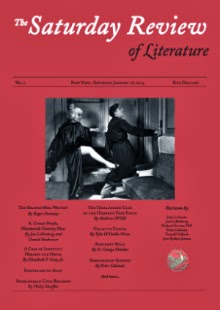
This article was originally published as The Mystery of the Two Three Irregular Plates in the January 18, 2014 issue of the Saturday Review of Literature, No. 2. Copies of this issue (as well as the 2013, 2015 and 2016 editions) are available for $5 each and more information can be obtained by contacting the SRL’s Editor HERE.
The original article was also published on Lellenberg’s BSI Archival History website.
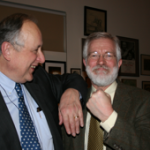 Jon Lellenberg (pictured, left, with 32nd Garrideb Dr. Richard Sveum, 2010) has co-edited seven collections of new Sherlock Holmes stories by mystery writers, most recently Sherlock Holmes in America (2009). Lellenberg has written or edited five books about A. Conan Doyle, the most recent “Dangerous Work”: Diary of an Arctic Adventure, co-edited with Daniel Stashower. Retired after 35 years in the U.S. Department of Defense, Lellenberg currently resides in Santa Fe, New Mexico.
Jon Lellenberg (pictured, left, with 32nd Garrideb Dr. Richard Sveum, 2010) has co-edited seven collections of new Sherlock Holmes stories by mystery writers, most recently Sherlock Holmes in America (2009). Lellenberg has written or edited five books about A. Conan Doyle, the most recent “Dangerous Work”: Diary of an Arctic Adventure, co-edited with Daniel Stashower. Retired after 35 years in the U.S. Department of Defense, Lellenberg currently resides in Santa Fe, New Mexico.

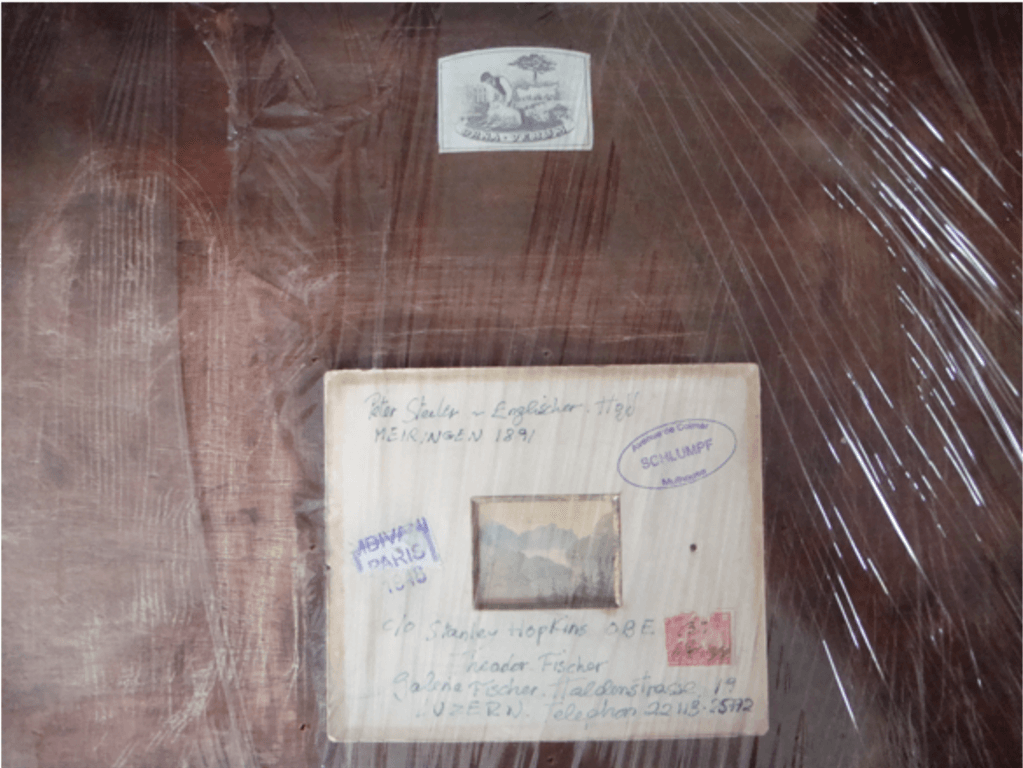
[…] recently reprinted Jon Lellenberg’s 2014 article on The Mystery of The Three Irregular Plates. To accompany his article, we are reprinting the auction lot descriptions of the subsequent auction […]
[…] recently reprinted Jon Lellenberg’s 2014 article on The Mystery of The Three Irregular Plates. To accompany his article, we are reprinting the auction lot descriptions of the subsequent auction […]
[…] recently reprinted Jon Lellenberg’s 2014 article on The Mystery of The Three Irregular Plates. To accompany his article, we are reprinting the auction lot descriptions of the subsequent auction […]
[…] recently reprinted Jon Lellenberg’s 2014 article on The Mystery of The Three Irregular Plates. To accompany his article, we are showing a flyer and color brochure that we believe were produced […]
[…] 18, 2014 of the Saturday Review of Literature that we have just reprinted here on our site as The Mystery of the Three Irregular Plates. Mr. Lellenberg kindly invited me to join him for breakfast one morning during the BSI Weekend in […]
This post was mentioned on page 4 of the April 2016 issue of Scuttlebutt from the Spermaceti Press, which can be viewed at http://redcircledc.org/assets/files/Spermaceti/scuttlebutt-2016.pdf
[…] The date of the dinner was the anniversary of the 1898 announcement that William Gillette would star in a stage production as Sherlock Holmes. (Thanks to A Curious Collection of Dates, Through The Year with Sherlock Holmes by Leah Guinn and Jaime N. Mahoney for that nugget of information. You can purchase that book HERE.) To honor the anniversary, we chose to illustrate the 1940 New York plate made by the American Bank Note Company for that year’s BSI dinner that features Frederic Dorr Steele’s vignette of Sherlock Holmes that was based on William Gillette’s performance. You can read more about that plate and the other two by clicking HERE. […]